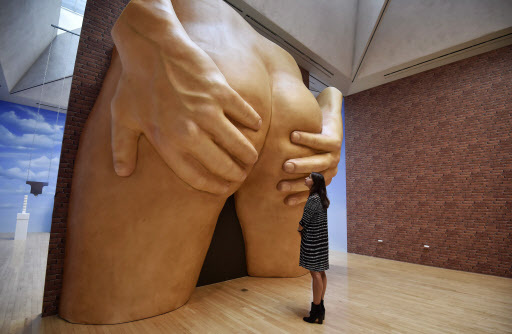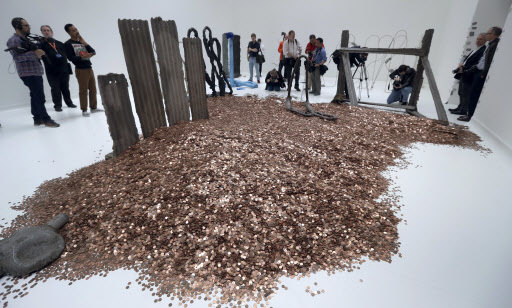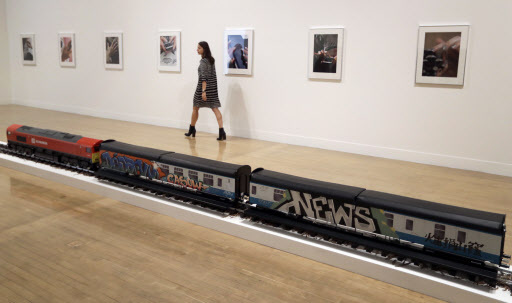Bums and cash set tongues wagging at UK's Turner Prize
By Korea HeraldPublished : Sept. 27, 2016 - 13:17
LONDON (AFP) -- A giant backside, a mountain of money and chastity belts suspended from a ceiling: the Turner Prize once again looks set to divide the contemporary art world after unveiling its finalists in London on Monday.
The four shortlisted artists have each taken over a room at Tate Britain, filling the famous gallery with all manner of materials, shapes and surprises for an exhibition that organizers hope will promote debate about art when it opens to the public Tuesday.
The prize is awarded to a British artist under 50 for an outstanding exhibition, and has become synonymous with controversy in its 32-year history with previous winners including contemporary art agents provocateurs Damien Hirst and Tracey Emin.
London-based finalist Anthea Hamilton’s work is likely to be the focus of sharp debate for this year’s exhibition -- an almost 5-meter high sculpture of a male backside and a series of metallic chastity belts suspended from the ceiling.
The four shortlisted artists have each taken over a room at Tate Britain, filling the famous gallery with all manner of materials, shapes and surprises for an exhibition that organizers hope will promote debate about art when it opens to the public Tuesday.
The prize is awarded to a British artist under 50 for an outstanding exhibition, and has become synonymous with controversy in its 32-year history with previous winners including contemporary art agents provocateurs Damien Hirst and Tracey Emin.
London-based finalist Anthea Hamilton’s work is likely to be the focus of sharp debate for this year’s exhibition -- an almost 5-meter high sculpture of a male backside and a series of metallic chastity belts suspended from the ceiling.

“Research is at the heart of her work,” Linsey Young, the curator of contemporary art at Tate Britain, told AFP. “She uses the research she does into maybe disco music or lichenography as a lens to look at the world.”
Fellow Londoner Helen Marten fashions sculptures from unusual materials such as fish skin and snooker chalk.
“She’s an artist who begins her work with writing, and then creates amazing assemblages of intricate, beautiful things,” Young said.
“She talks of wanting the viewer to be like an archaeologist, imagining the work through her objects.”
Third finalist Josephine Pryde’s exhibition mixes photography and sculpture, using everyday materials including kitchen worktops bleached by exposure to the sunlight in London, Athens and Berlin.
Her most eye-catching work is a scale model of a diesel locomotive graffitied by artists from cities in which the train has been exhibited.

“She's interested in display, in the way museums and people interact with art,” said Young.
The final exhibition features work by Michael Dean, from the northeastern English city of Newcastle, and features sculptures resembling distorted letters and body parts made using materials such as steel, soil, sand and corrugated sheet metal.
“Michael Dean is a sculptor who again starts with writing,” explained Young. “He writes poems and makes text and makes abstract fonts which he then translates into a sculptural form.”
The centerpiece of his show is the exhibition’s most overtly political piece, a mini mountain range consisting of 20,463 pounds ($26,456) in bronze one penny pieces.
The sum of money is equal to the government's definition of the poverty line for a family of two adults and two children in Britain.

The contemporary art prize, which is named after painter William Turner, has been awarded annually since 1984 and this year’s winner will be announced on Dec. 5.
Past winning entries include Hirst’s bisected cow and calf preserved in formaldehyde and Emin’s unmade bed, both of which triggered furious debate in Britain’s media.
However, Young insisted that the jurors -- experts from the art world -- did not deliberately seek controversy.
“We don’t set out to be provocative, but sometimes there is a giant bum in the room,” she said.
-
Articles by Korea Herald


![[Exclusive] Korean military set to ban iPhones over 'security' concerns](http://res.heraldm.com/phpwas/restmb_idxmake.php?idx=644&simg=/content/image/2024/04/23/20240423050599_0.jpg&u=20240423183955)

![[Graphic News] 77% of young Koreans still financially dependent](http://res.heraldm.com/phpwas/restmb_idxmake.php?idx=644&simg=/content/image/2024/04/22/20240422050762_0.gif&u=)



![[Pressure points] Leggings in public: Fashion statement or social faux pas?](http://res.heraldm.com/phpwas/restmb_idxmake.php?idx=644&simg=/content/image/2024/04/23/20240423050669_0.jpg&u=)










